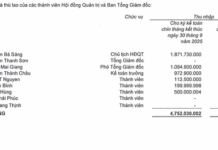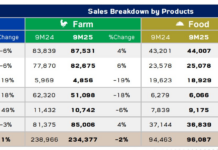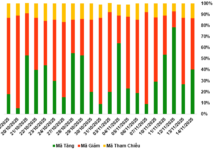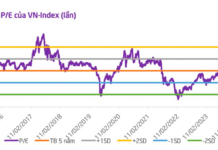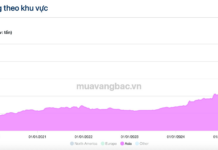The General Statistics Office’s report on the labor market situation in the third quarter and the first nine months of 2024 indicates that Vietnam’s labor market remained stable, unaffected by natural disasters or global market instability. The unemployment rate for this quarter was lower than in the previous quarter and the same period last year.
UNEMPLOYMENT SITUATION IMPROVES
Approximately 1.05 million people were unemployed during this quarter, a reduction of 22.2 thousand people from the previous quarter and a decrease of 24.3 thousand people compared to the same period last year.
The unemployment rate for this quarter was around 2.24%, showing a decline from the previous quarter and the corresponding period last year. Notably, the unemployment rate in urban areas remained below 3%.
According to the General Statistics Office, this positive development can be attributed to two main factors: the net entry of businesses into the market and the flourishing import-export situation. These factors have contributed to the decrease in the country’s unemployment rate this quarter.
Unemployed persons are defined as those aged 15 years and above who meet all three criteria: currently not working, actively seeking employment, and available to start working. The unemployment rate is calculated as the percentage of unemployed individuals relative to the labor force.
Additionally, the industrial production sector witnessed an increase compared to the same period last year. Various tourism promotion and stimulation programs were effectively implemented, boosting trade, transportation, and tourism activities.
For the first nine months of 2024, the country recorded approximately 1.06 million unemployed individuals aged 15 and above, representing a decrease of 5 thousand people compared to the same period last year. The unemployment rate for this period stood at 2.26%, a reduction of 0.02 percentage points from the previous year.
Thus, the unemployment situation in Vietnam for the first nine months of 2024 showed improvement compared to the corresponding period in 2023. However, it remained relatively stable around 2.2%, similar to the pre-COVID-19 era.
While this rate is still relatively high, it is worth noting that Vietnam’s socio-economic situation in the third quarter and the first nine months maintained a positive trajectory, yielding significant achievements and outperforming the previous year in various sectors. Additionally, the surge in recruitment demands has positively contributed to enhancing the current labor market.
YOUTH CONTINUE TO FACE CHALLENGES IN JOB SEEKING
According to the General Statistics Office, while the unemployment rate among youth (aged 15–24) decreased compared to the previous quarter, the rate of youth neither in employment nor in education or training increased.
The International Labour Organization’s (ILO) report, “Global Employment Trends for Youth 2024,” estimates the global youth unemployment rate at 13% for 2023, projected to decrease to 12.8% in 2024 and 2025.

In Vietnam, the unemployment rate among 15–24-year-olds stood at 7.75% this quarter, lower than the global average but still relatively high.
Compared to the previous quarter and the same period last year, this rate decreased by 0.26 and 0.11 percentage points, respectively. Notably, the unemployment rate in urban areas was 8.33%, 0.89 percentage points higher than in rural areas. When compared to the previous quarter, this rate increased in rural areas (up by 0.58 percentage points) and decreased in urban areas (down by 1.86 percentage points).
Furthermore, during this quarter, approximately 1.4 million youths aged 15–24 were neither employed nor engaged in education or training (accounting for 10.7% of the total youth population). This number increased by 75.3 thousand people compared to the previous quarter but decreased by 156.3 thousand people from the same period last year.
Typically, the third quarter experiences a rise in the rate of youth neither employed nor engaged in education or training, as many young people graduate from universities, colleges, or vocational schools during this period and are in the process of transitioning from the educational environment to the labor market.
This rate is higher in rural areas than in urban areas (12.5% vs. 7.9%) and higher for female youth than for male youth (12.2% vs. 9.4%).
According to the Ministry of Labour, Invalids, and Social Affairs, youth unemployment, particularly among 15–24-year-olds, remains a challenge for Vietnam’s labor market. Their report also revealed that, on average, one out of ten youths is unemployed. Young workers are also three times more likely to be at risk of losing their jobs than other age groups.
The General Statistics Office similarly assessed that the youth unemployment rate and the rate of youth neither employed nor engaged in education or training remain high in Vietnam. This reflects the difficulties faced by graduates when entering the job market.
Therefore, effective implementation of youth orientation and channeling programs is essential. Additionally, strengthening the connection between educational institutions and businesses can enhance graduates’ career prospects in their respective fields, optimize human resources, and significantly contribute to balancing labor supply and demand.
The Great Divide: Unraveling the Complexities of the Employer-Employee Disconnect
The disconnect between businesses and job seekers can be attributed to a multitude of factors. Apart from revamping recruitment strategies, HR experts suggest that having a standardized and accurate database of candidate information is crucial for businesses to easily connect with the right talent.
The Job Seekers’ Wage Slump: Why the Race for $10–$20 Million Monthly Salaries is Fizzling Out
According to statistics from the Hanoi Center for Employment Services, there was a nearly 10% decrease in the number of job seekers in the capital city expecting a salary of 10-20 million VND per month in July compared to the previous month. The majority of these individuals fell into the category of those without formal training, followed by those with a college degree or higher.
“Bridging the Skill Gap: Equipping the Next Generation with Hands-on Training”
According to experts, a strong collaboration between vocational schools and enterprises in training is the key to overcoming the current surplus of teachers and shortage of skilled workers in Vietnam. This approach not only benefits both parties but also ensures a win-win situation by enhancing the quality of human resources and guaranteeing job opportunities for graduates.













